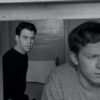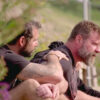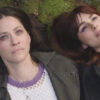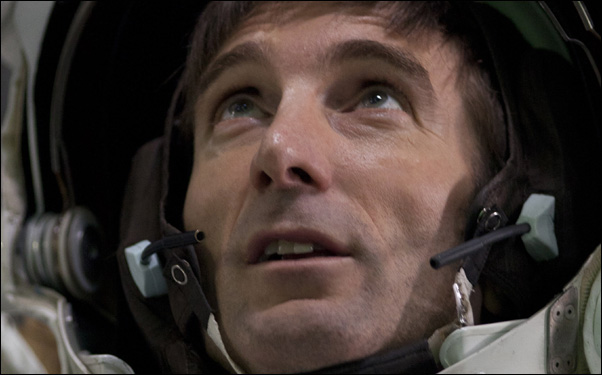With a post-production process over the course of 10 months that involved no fewer than four editors to whittle down the footage captured by eight cameras that ran simultaneously throughout the production, it was only slightly less difficult to make the new thriller “Europa Report” than it would be to send a crew out to Jupiter’s moon of Europa, as happens in the hardcore sci-fi flick.
However, just as the astronauts venture into the unknown on a wing and a prayer, so did Ecuadorian filmmaker Sebastián Cordero who emerged with something as strange and wondrous as outer space itself. Featuring a motley international cast including the likes of “District 9” star Sharlto Copley, “4 Months, 3 Weeks and 2 Days” star Annamaria Marinca, and the original “Girl With a Dragon Tattoo” star Michael Nyqvist as the crew searching for signs of life on the fifth planet from the sun, the JPL-approved film is both serious about its science and its suspense. Yet unlike most movies set in zero gravity, “Europa Report” doesn’t envision life on a space shuttle as claustrophobic and dark, but instead presents its mission in crisp, clean detail where the hope for discovery far outweighs the fear the crew may have.
Cordero must’ve felt the same way during production, operating on a miniscule margin of error as he and cinematographer Enrique Chediak developed a way to film from the outside of a concealed set in which the actors would really feel as if they were in space, complete with what the filmmaker refers to as “poor man’s zero gravity” where green yoga balls and men in green suits that were later painted out helped to create the illusion of levitation. Still, the film’s impressive commitment to accuracy will no doubt have hardcore sci-fi fans floating above their seats with the same joy as those who simply believe in the possibilities of space exploration.
Just after the film’s premiere at the Los Angeles Film Festival in June — the first time Cordero had seen the film with a crowd not consisting of NASA consultants or his cast and crew — the director spoke about making his English-language debut with a completely different mode of storytelling than his previous films “Cronicas” and “Rabia,” keeping things resonant on a human level in space and putting himself in the mindset of a scientist.

It was. We finished it in December, which is now a few months ago, but the distribution was secured and I went back home to Ecuador after finishing post and I had seen it again with friends and family at home, but not in a theater and it was great to see it with a real crowd and to hear the reactions. It really gave me a new perspective on the film.
What perspective was that?
Just the fact that when you’re making a film, it’s very hard to be objective in terms of what are the real connections that are happening with the audience. It’s incredible how much each screening can change, even if the film is the same, and how you might perceive it differently. [With “Europa Report”], one of the big challenges of this film was that because of the conceit of the found footage from the monitoring cameras that don’t move, you don’t have the usual tools that another film would.
There were many moments where I was afraid that people would be a little bit too removed and that it would be hard to make a real emotional connection. Watching it [with an audience], I realized that emotional connection is there throughout. There is a crescendo, there is a buildup and it’s working really well. It’s funny because there are things that you think are going to be the issues and it always surprises you with the finished film that the issues are usually other issues. [laughs]
Because it’s a different way to tell a story, you must’ve felt limited at first, but once you figure out the format, it must open up all sorts of possibilities.
Absolutely. It got really tricky. The post-production got crazy because there were so many things going on. The editing of the film in itself is complex when we started playing with multiple screens and things like that. You also have monitors within the frame that also have to have content in there. But visually, one of the things that Enrique [Chediak], the DP, was really interested in when we started working was let’s not design this film for aesthetic reasons. Let’s think it through as if it was really a scientist putting the camera there. Why is he putting the camera there? What is it that they’re interested in capturing from each camera?
We thought of each camera in terms of the personality of each camera, particularly the way they were going to be degraded later on and distressed, [such as] when a camera stops working or falls off its spot and suddenly everything from that camera is sideways from the ground or goes out of focus. With a character approaching the camera and you never quite manage to focus for real, in any other film, that would be a mistake. You could not incorporate it. Here, it is the source of more tension. The fact that a crucial moment for a character might happen slightly offscreen, it’s great. It gives you more. All those things we were able to play with and it’s almost like a different bag of tools. It’s not the usual tools, but there’s a lot to explore with the other tools.
One of the most interesting things to me about the film is how it’s a thriller, but it’s hopeful. When you see films that are in space, the unknown is treated as this grim, terrible wasteland, usually shot with grime and skittish violins for a score. Here, you’ve got this soaring score and it’s gleaming. How did that style come about? It’s such a refreshing and optimistic take on space.
It is and it isn’t because it does deal with some of the big issues that I think human beings deal with from a psychological perspective of what are you willing to give up for a big discovery. What are you willing to sacrifice for the sake of mankind versus for your own personal gain or to keep your comfort? This crew of astronauts all know that they might not make it home alive, that the journey is going to take a toll on them, that it’s going to be a big sacrifice. However, the sense of discovery and the awe behind what they could find, it’s really their big drive.
It’s almost mythical and we talked a lot with each of the actors about certain myths. For instance, even though it’s a recurring element in several science-fiction myths, Icarus — [where] you’re approaching the sun and that knowledge may end up being [what] burns you — it’s something that can be so beautiful and enlightening, I think that was a crucial element.
I also feel like for this movie more than any other I’ve done, I was being a catalyst and really letting the movie express how it should be executed. The idea of light versus darkness [is] recurring. The motto of the spaceship [and] the mission is “Post Tenebras Lux,” which [means] “After darkness, there will be light” and it’s very symbolic in terms of going through this huge, very difficult two-year journey to reach a goal where you will have very little time to actually get to what you’re after and at the same time, the possibility of making a huge discovery and not being able to share it with the world. There’s a lot at stake, but we always thought that it would be great if a lot of that light that we associate with knowledge, with discovery, permeated the film. Obviously, the third act is darker, but that awe and discovery is crucial.
What drew you to make the film in the first place?
It’s the first time that I didn’t generate [the story] from scratch. When I first read it, it was a mixture of the possibility of exploring something I had never done before, but which really fascinated me. As a teenager, I was a big science-fiction reader. I read a lot of short stories, whether it was Isaac Asimov or Phillip K. Dick or Theodore Sturgeon, and it always seemed like it was a little bit of a phase that I left behind.
When I was studying film and then went back to Ecuador to make films, it didn’t even seem like a possibility to go in that direction. It was just like if I make films in Ecuador, we’re stuck with a gritty, realistic depiction of things. I’m absolutely happy with that and it’s stuff that I want to keep working on, but suddenly it was the opportunity of doing something like a childhood dream, but with the responsibility attached to it that you owe a lot to science and to science-fiction fans.
I’ve always hated when I’ve watched found-footage movies that breaks their rules. I’ve always felt like why? You can still do something thrilling and you can work the story out in a way that you don’t need to break the rules, which just felt like a nice challenge. The opportunity to also work with an international cast, the enclosed space, all that — it held a lot of possibilities from the beginning. I was also thankful that since “Cronicas,” I’ve been looking more actively to make an English-language film and this was so different from the other stuff that I had been reading. I’m really driven by projects that are unique in a way and this had a lot of the right elements there.

That was the biggest challenge on this film. Because of the [found footage] device and the way the story’s told, there’s very few moments where the characters can open up. Normally, when I’m writing the screenplay, I want to make sure all the complexities and all the humanity of the characters are there and there’s a lot of things that you devise to be able to work that out. Here, you really had to go drop by drop.
Suddenly, there would be an opportunity for a character to express [something], whether it was a fragile moment or some moment of weakness. [Anamaria Marinca’s character] Rosa had a lot of opportunities with her interview and it’s more of a confessional thing, so she could connect in that way, but for instance, [Daniel Wu’s character] William is almost like a robot. That’s the way the character’s devised, so it was a challenge finding those little moments. It has a lot to do with tone. That distance throughout, the moments where that’s broken and where you have some more connection with the characters, you really feel those. You feel those in a different way than if the film had a lot more of that open emotionality from the characters throughout. Some of those elements were in there in the script, some of them we worked out through pre-production and then with the actors, that definitely was one of the trickiest things. and I’m happy that I think the film found its equilibrium.
One of the things you alluded to at the premiere was that the way the [physical] setup for filming the astronauts in the shuttle was such that it was like looking in on an interrogation room where you couldn’t actually go in and talk to them.
Yeah, I wasn’t even in there with them. That was tough because you want to be able to have all this intimacy with your actors and talk to them about things that everyone else should not be hearing and here it was basically like directing on a stage with everyone watching, listening to what everyone else is being told. It definitely makes you more vulnerable, but after a couple days, you just get used to it.
Your first English-language film, your first science-fiction film, working with an international cast — was it good to get all of these different experiences out of the way on one film?
It worked for me. I really enjoyed it. It almost felt like it was a puzzle to solve in many ways and I like a good challenge.
“Europa Report” opens on August 2nd in Los Angeles at the Sundance Sunset Cinemas, New York at the Cinema Village and in Washington DC at the E Street Cinema and will expand in the coming weeks. A full schedule is here. It is currently available nationwide on VOD.





Comments 2